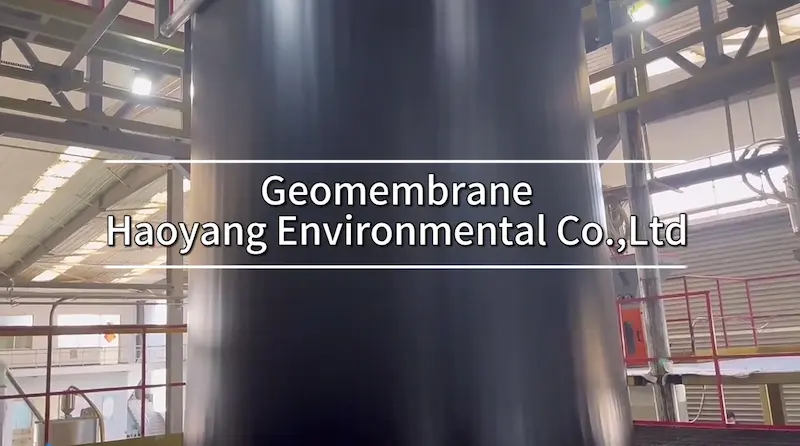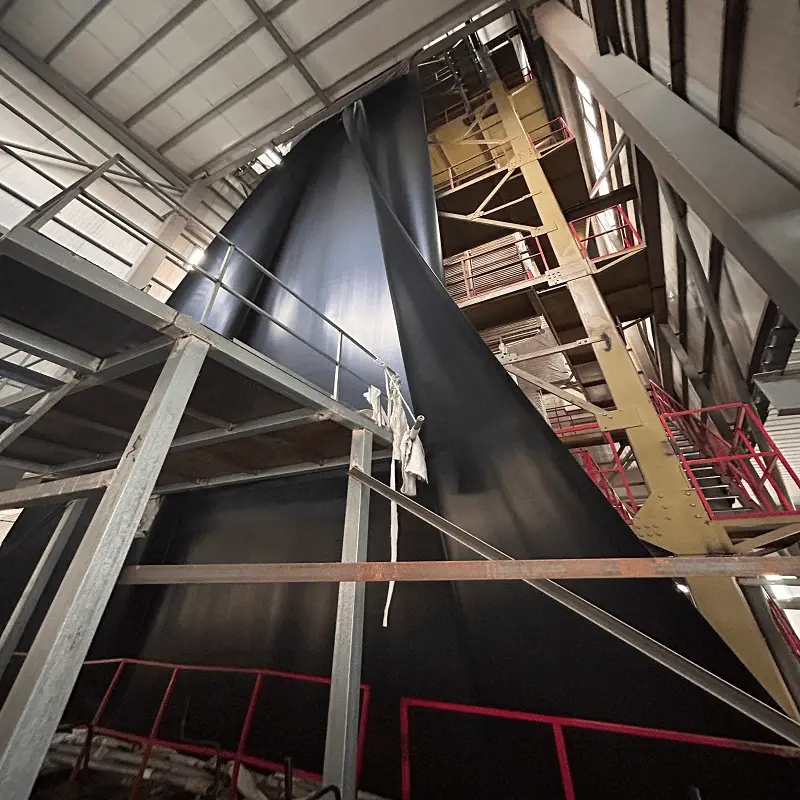Edited by Lucia-Haoyang Environmental
I. The Significance of Tailings Pond Protection in Mining
In the mining industry, tailings ponds are essential yet challenging components. They store waste from ore extraction, but if not managed properly, can lead to severe environmental and safety issues. The integrity of these ponds is crucial as any leakage can contaminate soil, groundwater, and nearby water bodies, endangering ecosystems and human health. This is where High-Density Polyethylene (HDPE) geomembranes come into play, providing a reliable solution to safeguard these sites.
335676.webp)
II. Unveiling HDPE Geomembranes
1. Material Composition and Its Magic
HDPE geomembranes are crafted from high-density polyethylene, a thermoplastic polymer. Its molecular structure, with closely packed chains, grants it remarkable properties. Compared to other plastics like LDPE, HDPE has a significantly lower permeability rate, typically ranging from 1×10⁻¹³ to 1×10⁻¹⁵ cm³/cm²·s·cmHg. This makes it highly effective in containing the potentially harmful substances in tailings. For instance, in a lab test, while LDPE allowed some liquid to pass through, HDPE almost completely blocked it, highlighting its superiority.
Material | Permeability Rate (cm³/cm²·s·cmHg) |
HDPE | 1×10-13 - 1×10-15 |
LDPE (for comparison) | 1×10-11 - 1×10-13 |
2. Key Properties That Matter
l Strength and Durability
HDPE geomembranes boast high tensile strength, vital for withstanding the stress from tailings and ground movements. Depending on the grade, they can handle tensile forces up to several hundred pounds per inch width. In a long-term study at a gold mine in South Africa, HDPE geomembranes installed 20 years ago still showed minimal degradation, effectively protecting the pond.
Grade | Tensile Strength (pounds per inch width) |
Standard Grade | 200 - 300 |
High-Performance Grade | 300 - 400 |
l Chemical Resistance
Mining tailings contain a variety of chemicals. HDPE geomembranes can resist a wide pH range, from acidic solutions like sulfuric acid (pH 2) to alkaline ones like sodium hydroxide (pH 13). At a zinc mine in Canada, the geomembrane has successfully contained acidic tailings for over a decade, preventing soil and water contamination.
Chemical | Resistance Level |
Sulfuric Acid (pH 2) | High |
Sodium Hydroxide (pH 13) | High |
3. The Manufacturing Precision
HDPE geomembranes are made through extrusion. The HDPE resin is melted at 200 - 230°C and forced through a die to form a sheet. By controlling parameters like extrusion speed (5 - 10 m/min), manufacturers ensure consistent quality. A leading manufacturer in the US saw a 20% reduction in production defects after optimizing these parameters.
Parameter | Range |
Extrusion Temperature (°C) | 200 - 230 |
Extrusion Speed (m/min) | 5 - 10 |
 (1)296793.webp)
III. HDPE Geomembranes in Action at Tailings Ponds
1. Leakage Prevention: A Game-Changer
The primary role of HDPE geomembranes is to prevent tailings slurry leakage. In a vast iron ore mine in Australia, spanning over 500 hectares, the pre-HDPE era was marred by significant leakage problems. Before installation, seepage rates were measured at an alarming 50 liters per square meter per day, contaminating local waterways and degrading soil quality. However, after a meticulous installation of 2.5 mm thick HDPE geomembranes, the leakage rate dropped to a mere 0.5 liters per square meter per day within a year, representing a staggering 99% reduction. This not only protected the surrounding environment but also reduced the financial burden associated with potential environmental remediation.
Mine Location | Before Installation (Leakage Rate) | After Installation (Leakage Rate) |
Australian Iron Ore Mine | 50 liters per square meter per day | 0.5 liters per square meter per day |
2. Structural Stability Enhancement
HDPE geomembranes help distribute tailings weight evenly, preventing differential settlement. In the mountainous copper mines of Chile, where seismic activity is frequent, stability is a constant concern. A combination of 1.5 mm HDPE geomembranes and geotextiles was employed. The non-woven geotextile beneath the geomembrane, with a tensile strength of 800 N/m, cushioned against punctures. The woven geotextile on top, having a tensile strength of 1200 N/m, aided in load distribution. This setup reduced settlement-related incidents by 45% over a five-year period, ensuring the safety of mining operations and minimizing the risk of catastrophic failures.
Mine Location | Stabilization Method | Outcome |
Chilean Copper Mines | HDPE (1.5 mm) + Non-woven Geotextile (800 N/m) & Woven Geotextile (1200 N/m) | 45% reduction in settlement issues |
3. Meeting Stringent Regulations
Globally, strict regulations govern tailings pond management. In the United States, mines in areas prone to heavy rainfall and flooding, like parts of the Appalachian region, must adhere to strict standards. For example, a coal mine in West Virginia was required to install HDPE geomembranes with a minimum thickness of 2.0 mm and a specific UV resistance rating of at least 500 hours of exposure without significant degradation. By complying with these regulations, the mine was able to operate smoothly, preventing any potential environmental disasters during extreme weather events.
Country | Regulatory Requirement |
US (Appalachian region example) | Minimum thickness 2.0 mm, UV resistance ≥ 500 hours |
497238.webp)
IV. Navigating Industry Standards
1. Chinese Standard GB/T17643-2011 Insights
The GB/T17643-2011 standard specifies the classification, product codes, and raw material requirements for HDPE geomembranes used in China.
Classification | Details |
GH-1 | Ordinary high-density polyethylene geomembrane |
GH-2S | Environmentally friendly double-smooth high-density polyethylene geomembrane |
GH-2T1 | Environmentally friendly single-rough high-density polyethylene geomembrane |
GH-2T2 | Environmentally friendly double-rough high-density polyethylene geomembrane |
l Physical Properties
The Chinese standard dictates that HDPE geomembranes should have a density of 0.939 - 0.945 g/cm³ and tensile strength at break of at least 20 MPa in the machine direction and 18 MPa in the transverse direction. A Chinese mine in Inner Mongolia that adhered to these standards had no reported geomembrane failures in five years.
Property | Requirement |
Density (g/cm³) | 0.939 - 0.945 |
Tensile Strength (Machine Direction, MPa) | ≥ 20 |
Tensile Strength (Transverse Direction, MPa) | ≥ 18 |
l Impermeability
It specifies a maximum hydraulic conductivity of 1×10⁻¹³ cm/s. Tests in Chinese research institutions showed that compliant geomembranes effectively blocked contaminant migration, protecting soil and water.
Property | Requirement |
Hydraulic Conductivity (cm/s) | ≤ 1×10⁻¹³ |
2. American Standard GM13 Highlights
l Durability Requirements
GM13 demands a minimum 50-year service life under normal conditions. Accelerated aging tests, including 5000+ hours of UV radiation, ensure resistance to degradation. A US-based mine that used GM13-compliant geomembranes reported no significant wear after 10 years.
Requirement | Details |
Service Life | ≥ 50 years |
UV Radiation Test Duration (h) | ≥ 5000 |
l Installation Guidelines
The standard requires welding strength to be at least 85% of the base material strength. In Colorado mines, strict adherence to these guidelines led to seamless installations and reliable containment.
Installation Guideline | Requirement |
Welding Strength (% of base material strength) | ≥ 85 |
 (1)447500.webp)
V. The Future Outlook
As the mining industry advances, the demand for more effective and effective and sustainable tailings pond management will grow. HDPE geomembranes will continue to evolve, with potential improvements in material composition and manufacturing processes. New additives may enhance their resistance to even harsher chemicals, and advanced installation techniques could further reduce installation time and costs.
Moreover, as environmental awareness rises, stricter regulations will likely emerge, pushing manufacturers to innovate. In conclusion, HDPE geomembranes remain the cornerstone of responsible tailings pond management, protecting our environment and enabling sustainable mining practices.
![]() 2mm smooth geomembrane report.pdf
2mm smooth geomembrane report.pdf
If you are interested in any of our products, pls feel free to contact me:
Tel: +86 16615773081
Email: lucia@hygeosynthetics.com
742.webp)
 (1)688.webp)
989.webp)



311.webp)
889.webp)
231.webp)